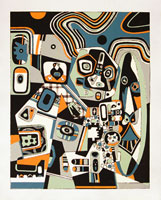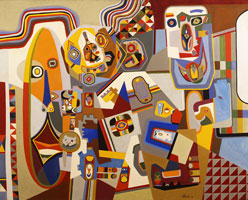
The Story Behind "Hello Steve"
Serving in the navy during World War II, Wheeler produced isometric drawings of machine parts as part of the war effort. These illustrations may have inspired the complex intricacy of his work in the postwar years.
During this period, Wheeler began to spin many paintings out of each of his motifs, typically initiating his experiments in gouaches. The result would be a kaleidoscopic interplay of motifs in an "all-positive space," with ever-changing relationships between objects and ground. Out of these simultaneous sensations emerged a sense of urgent, non-linear narration.
The very first color print in "Hello Steve" reflects the artist's keen interest in both archetypes and popular culture. "Two Smiles" was inspired by a contemporary story about an Indian youth rolling a hoop; in this print, both boy and hoop wear a smile.
The artist described his process as "painting a book," in which "Paper, typography and pictures move together." "Hello Steve" can in fact be considered a kind of self-portrait—a "portable mural of things in and around my life." Unsurprisingly, many of the mask-like heads appearing throughout the book suggest the artist's own likeness.
In a time of great cultural ferment and experimentation—and before Abstract Expressionism assumed center stage—Wheeler sought to bring to the public "the new direction painting was taking."

